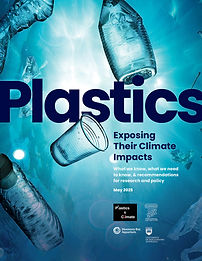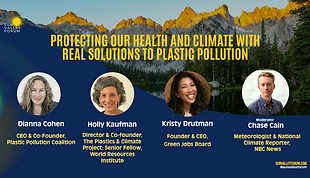Report
New Report:
Plastics: Exposing Their Climate Impacts
What we know, what we need to know, & recommendations for research and policy
This is the first report to comprehensively assess the existing peer-reviewed data on the climate impacts of plastics. The report analyzes existing peer-reviewed data, identifies critical data gaps, lays out a roadmap for continued research, and recommends policies and actions to support that research and to include plastics’ climate impacts in relevant models, scenarios, accounting, and analyses.
The report is authored by The Plastics and Climate Project's Holly Kaufman and Dr. Xia (Alice) Zhu, and the Environmental Law Institute (Cecilia Diedrich and Dr. John Doherty), with key input from the Monterey Bay Aquarium and Dr. Karen Raubenheimer, University of Wollongong, Australia. The report is a non-technical summary of The Project’s peer-reviewed paper, “The knowns and unknowns in our understanding of how plastics impact climate change: A systematic review,” published in April 2025 in Frontiers in Environmental Science.
These publications outline the current understanding of how plastics affect the climate across their lifecycle, through the emission of greenhouse gases, impacts on the carbon cycle, and through radiative effects. The authors highlight significant data gaps in quantifying these impacts and propose a research agenda to address these shortcomings. They emphasize the need for more comprehensive studies on greenhouse gas emissions at every stage of the plastic lifecycle, the effects of plastic pollution on carbon sinks in various ecosystems, and the influence of plastic particles on Earth's energy balance.
The report offers recommendations for public and private sector actions to spur the needed research and to ensure that the climate impacts of plastics are considered in relevant assessments and policies. The findings and proposals are intended to raise awareness and motivate action by policymakers, scientists, industry, investors, educators, and non-governmental and community representatives.
Please access the report here.
See what the experts are saying about the report
Dr. Sylvia Earle, Monica Medina, and others.
Videos
Climate Impacts of Plastics in 77 Seconds
Presenter:
Holly Kaufman, The Plastics & Climate Project

"Plastics: Exposing Their Climate Impacts"
Speakers:
Holly Kaufman, The Plastics & Climate Project
Alice Zhu, The Plastics & Climate Project
U.S. Senator Sheldon Whitehouse
Angela Anderson, WRI
Dr. Sweta Chakraborty, Panel Moderator
Panelists:
Jo Banner, The Descendants Project
Zachary Byrum, WRI
Dr. John Doherty, Environmental Law Institute
Monica Medina, Former Assistant Secretary of State
The World Resources Institute (WRI) hosted the event at the American Association for the Advancement of Science (AAAS), with viewers around the world.

Holly Kaufman: CNN Int on UN Plastics Treaty, Plastic Recycling
Interviewer:
Rosemary Church, CNN International
Speaker:
Holly Kaufman, The Plastics & Climate Project

Sun Valley Forum 2025: Plastics' Climate, Health, & Justice Impacts and Solutions
Interviewer:
Chase Cain, NBC Universal
Speakers:
Holly Kaufman, The Plastics & Climate Project
Dianna Cohen, Plastic Pollution Coalition
Kristy Drutman, Browngirl Green

Repository
Below is sampling of the nearly 6,400 peer-reviewed papers reviewed for the Project's Frontiers in Environmental Science and additional reports cited in the "Plastics: Exposing Their Climate Impacts" report. Many of those publications are included in the free, public repository of resources on climate-relevant plastic impacts that the Project has assembled. The repository and publications below are grouped into the three major categories of plastic's impacts on climate.
Climate Impact #1:
Emissions of greenhouse gases and black carbon from the plastics lifecycle

Greenhouse gas emissions from industry. Photo credit Roxanne Desgagnes on Unsplash
The following documents help identify and quantify the emissions of greenhouse gas emissions (including methane and ethylene) and black carbon across the lifecycle of plastics, from fossil fuel extraction to end-of-useful-life treatment or degradation in the environment:
-
C-THRU (2022) Carbon clarity in the petrochemical supply chain
-
Ford, Jambeck et al (2022) The fundamental links between climate change and marine plastic pollution
-
GRID-Arendal (2024), Climate impacts of plastics: Global actions to stem climate change and end plastic pollution
-
Lawrence Berkeley National Laboratory (2024), Climate Impact of Primary Plastic Production, Karali, N., Khanna, N., & Shah, N.
-
Scientists’ Coalition for an Effective Plastics Treaty (2023) Policy Brief: Climate change impacts of plastics, Nihan Karali, Ellen Palm, Juan Baztan, Patricia Villarubia Gomes, Nina Khanna, et al
Climate Impact #2:
The impact of plastics on carbon cycling including sequestration

Microplastics in zooplankton. Photo credit Cole et al.
These documents help identify and quantify the climate-relevant impacts of plastics on carbon cycling, including on carbon fluxes, sources, and sinks:
-
Galgani and Loiselle (2020) Plastic pollution impacts on marine carbon biogeochemistry
-
Shen et al. (2023) Recent advances in the research on effects of micro/nanoplastics on carbon conversion and carbon cycle: a review
-
Stubbins et al. (2021) Plastics in the Earth system
-
Zhao et al. (2023) Effects of plastic contamination on carbon fluxes in a subtropical coastal wetland of East China
-
Zhu, X. (2021) The plastic cycle - an unknown branch of the carbon cycle
Climate Impact #3:
The impact of plastics on the Earth's radiation budget

Ice cover and atmospheric aerosols affect the Earth's radiation budget. Photo credit Chris Boutillier on Unsplash
These resources investigate the changes in Earth surface albedo, direct aerosol effects, and/or indirect aerosol effects due to environmental plastics:
-
Revell et al. (2021) Direct radiative forcing of airborne microplastics
-
Leahy (2019) Microplastics are raining down from the sky, National Geographic
-
Xu et al (2023) Characterization of Microplastics in Clouds over Eastern China
Also see for all three categories of impacts:
-
Villarrubia-Gomez et al. (2024) Plastics pollution exacerbates the impacts of all planetary boundaries




